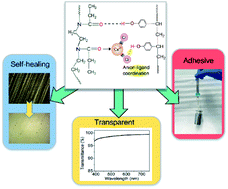Self-healable transparent polymer/salt hybrid adhesive via a ternary bonding effect†
Abstract
Tremendous attention has been focused on the design and fabrication of intrinsic self-healing materials in recent years; however, the fabrication of self-healing materials with high transparency and high adhesion strength is still a challenge. Here, we develop a novel transparent self-healing adhesive with multiple functions by simply blending poly(2-ethyl-2-oxazoline) (PEOZ), poly(4-hydroxy styrene) (PHS), and CaCl2, and discover that the anion Cl− also plays a significant role in accelerating the self-healing process by anion–ligand coordination in the form of hydrogen bonding, which has been seriously neglected in previous work. Unlike the common single metal–ligand coordination approach, the enhancement of self-healing results from novel co-existing ternary bridging bonds: metal–ligand coordination, ionic bond, and anion coordination. The universality of the new concept has been verified with other typical soluble salts MgCl2, NaCl, and Ca(NO3)2, providing a new dimension in the comprehension of the self-healing mechanisms. As a result, the hybrid shows outstanding multifunctional performance compared with the most recently published self-healable adhesives taking into consideration the transparency (T550 = 98.9%), adhesion strength (2.57 MPa), and self-healing efficiency (91%), enabling its application as an optical material, an adhesive and also a conservation material for cultural heritage.

- This article is part of the themed collection: Polymers in liquid formulations


 Please wait while we load your content...
Please wait while we load your content...